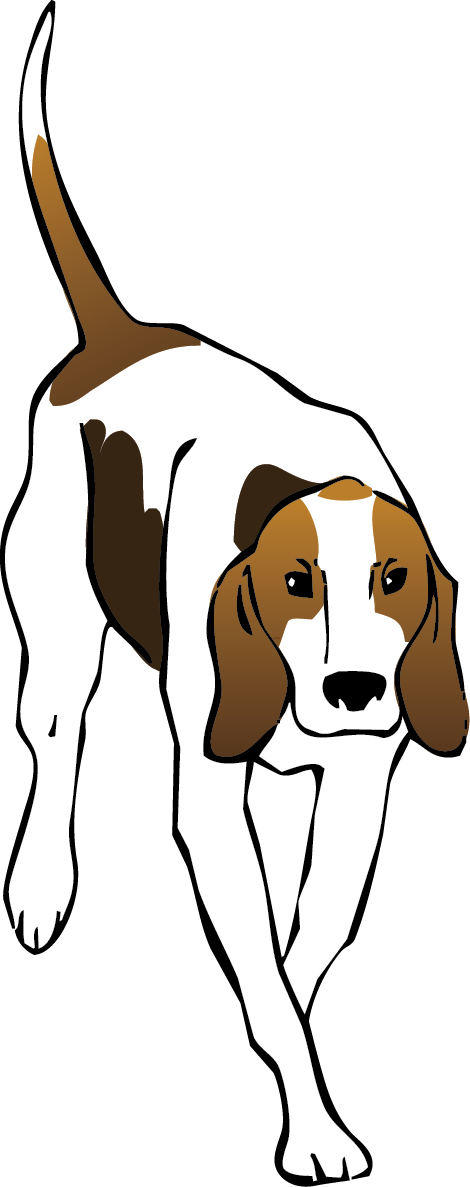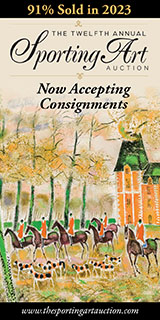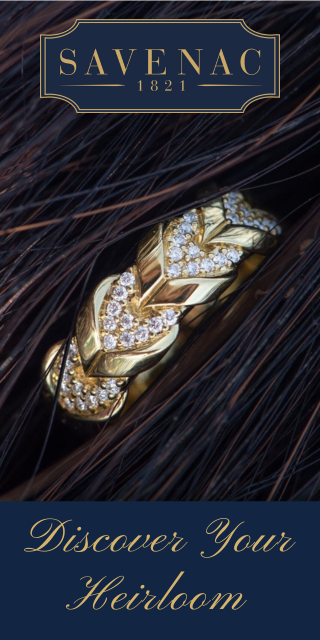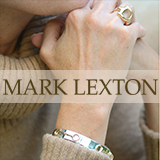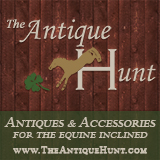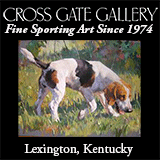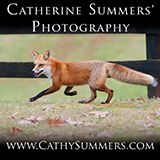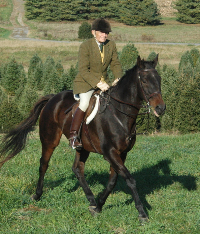 The author in informal cubhunting attire / Nancy Kleck photoTraditional foxhunting attire is important to me, but I’m not a fanatic.
The author in informal cubhunting attire / Nancy Kleck photoTraditional foxhunting attire is important to me, but I’m not a fanatic.
Why is it important? Respect…for three hundred years of sport, art, literature, and the men and women who had the passion, energy, and intellect to formulate and leave us one of the most exhilarating activities known to man. For these reasons it pains me to see the concepts of appropriate attire ignored in many hunting fields today.
There is good reason to dress modestly and uniformly. Foxhunting is about the hounds and the quarry; it’s not a stage for man or horse. Its dress code can be described as stratified uniformity—stratified between staff, Master, and field so we can quickly identify who’s who in the heat of battle, and uniformity so that we all maintain our modest place in the overall scheme of the sport.
Why, on the other hand, am I not fanatical about correct hunting attire? Because there is no single truth.
Many who claim to know the truth are only carrying the word as it was handed down to them by their mentors. And that word varies according to geography and local custom.
The question of what to wear is already rife with confusion and contradiction by learned and acknowledged experts. Add to those ambiguities the fact that hunting attire has evolved over the centuries to take advantage of developments in fabrics, comfort, and safety. And, finally, we must recognize that our North American climate—unlike that of England—ranges from sub-polar to sub-tropical. For these reasons, a “one rule fits all” approach makes no sense.
 Although white breeches with formal coats are traditional, the livery of the Old Dominion Hounds calls for rust breeches as Gus Forbush, MFH demonstrates. / Karen Myers photoConfusion and Contradiction
Although white breeches with formal coats are traditional, the livery of the Old Dominion Hounds calls for rust breeches as Gus Forbush, MFH demonstrates. / Karen Myers photoConfusion and Contradiction
A fellow I know who had been foxhunting only a few years was awarded his colors and had found himself a beautiful scarlet frock coat. He asked me if he could wear buff breeches, of which he had an abundant supply, with his new coat. I replied, “You should wear white breeches with your scarlet coat.” He appeared dutifully at the next meet—a drizzly, muddy day—in his scarlet coat and white breeches. He dashed over to me in indignation when he saw my scarlet coat and buff breeches. “I thought you said I couldn’t wear buff breeches with my red coat.”
“I said you should wear white britches, but I never say you couldn’t wear buff,” I replied. A perfect example of the confusion between strict rules and common sense. How was he to know that under ideal weather or terrain conditions white is preferred, but buff is also generally acceptable.
Or is it? It all depends on which expert you rely on. Wadsworth and Barney (see list of reference sources below) insist on white breeches with a frock coat. The MFHA (see reference sources below) specifies white, tan, rust, canary or buff. At the Devon and North Somerset Staghounds, sporting artist Cecil Aldin tells us (Ratcatcher to Scarlet) that you may wear any color breeches you wish…except white! Would that I had read Aldin’s book before I hunted there. I ruined for all time a pair of white breeches from which the mud stains could never be eradicated.
I spoke some years ago on this subject at the Bosley-Brangier Open House in St. Michaels, Maryland, where several people there cited Wadsworth as their reference of choice. I opened Wadsworth to page 11 where the author says that a gentleman’s coat should have “either four or five…buttons in front.” “Oh, no!” groaned the Wadsworth adherents.
Now William P. Wadsworth, MFH, was indeed a respected authority on hunting. His father founded the Genesee Valley Hunt (NY), and both men were elected president of the MFHA in their time. But no other hunting authority of any era would agree with Wadsworth on that point. It is universally agreed by all other authorities that a gentleman member wears three buttons on the front of his coat; a Master wears four buttons; a huntsman wears five; and a Master who hunts his own hounds wears five.
The MFHA in the 1930s continued the confusion. They advised the American Horse Shows Association that the number of buttons for a gentleman member should be the same as the Master’s coat, which they specified to have four buttons. This was published by the AHSA in their rule book for the next forty-plus years of hunt team and Corinthian classes and was never altered by subsequent MFHA review committees until late in the twentieth century.
When I asked the representative of a major U.S. manufacturer of hunting coats why his firm manufactured all frock coats with four buttons, he replied that four buttons was correct. He knew it was correct because he read it in the Hunt Roster Issue of The Chronicle of the Horse.
So, if a foxhunter joins your field wearing a frock coat with four buttons, how fanatical can you be when Wadsworth, the MFHA, the AHSA, and the manufacturer are or at one time were all behind him?
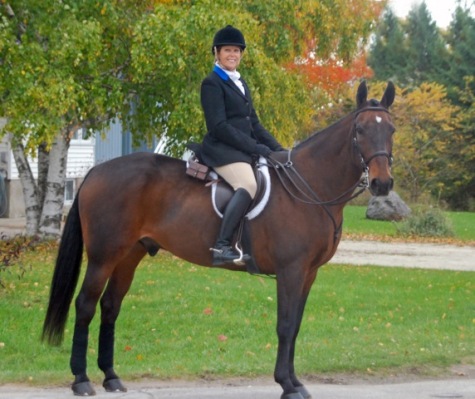 Denya Massey Clarke, a lady member of the field in formal attire, wearing the colors of the Toronto and North York Hunt / Michael Scime photo
Denya Massey Clarke, a lady member of the field in formal attire, wearing the colors of the Toronto and North York Hunt / Michael Scime photo
Tradition and Evolution
A yearning for tradition does not necessarily imply that nothing in foxhunting should ever change. Sydney Barney put it nicely when he said that “blind adherence to tradition should never be an excuse for arrested development.” The history of foxhunting attire is one of continuous evolution as technology has brought us new fabrics and materials that provide greater comfort and safety in the field. Hunting headwear is a prime example.
The top hat was an invention of the hunting field. Its high, stiff crown was designed to absorb shock when a rider fell on his head. It was the first crash helmet, and, according to the St. James Gazette of January 16, 1797, when it was finally seen on the streets of London women fainted, dogs yelped, and children screamed.
The hunting derby (or billycock) came along some fifty years later when a foxhunter named William Coke (William Coke=billycock!) grew tired of having his top hat knocked off by tree branches. He went to a hatmaker—a member of the Derby family—and worked out the design of a new crash helmet. The crown was lowered, rounded, stiffened, and an inside leather browband adjusted with a drawstring was added.
The new ASTM/SEI hunt caps and shells we wear today with harnesses and shock absorbing foam are the result of further technological progress to keep us safer and healthier. Change is good when it accomplishes a worthwhile purpose, and covered with plain black velvet the new headwear acknowledges tradition. However, a medallion or a shiny plastic racing stripe on the helmet doesn’t make us any safer and departs from tradition. Would that tack shops catering to foxhunters insist that the manufacturers give us more options that hew to tradition.
Huntsman Tony Gammell in formal attire with the hounds of the Keswick Hunt / Liz Callar photo
The North American Climate
I said earlier that there is no single truth when it comes to correct attire. In fact, there is one single truth—your Master. Whatever your Master specifies for your field is the truth as far as you’re concerned. And that prerogative is your Master’s golden opportunity to codify what’s appropriate for your hunt and at the same time preserve the precepts of appropriate attire. (If only all Masters today were willing to assume that responsibility!)
But let’s be sensible in doing so. The specific tenets of correct attire were developed in England. That island, surrounded by a great equalizing ocean, has a more consistently uniform climate and hunting terrain than does North America. From north to south and from east to west, the climate here varies from nordic to tropic and from wet to dry. The terrain varies from flat to mountainous, from rocky to sandy, and from arid to swampy.
Moreover, as mounted foxhunting developed on this continent through the nineteenth and early part of the twentieth centuries, the practitioners who wrote our rules were mostly localized in the northeastern and mid-Atlantic states where, again, climate and geography were relatively uniform. With organized, mounted hunting now spread all across the continent, how can we be reasonably expected to adhere to a dress code where one size fits all?
This is where your Master, mindful of traditions worth respecting, might articulate a modified dress code for your hunt for those months when you experience extreme weather.
What to Wear
Click on Attire, Tack, and Appointments under the Resources drop-down menu above for a guide to proper and appropriate attire that will render the wearer acceptable in any hunt field.
Other authoritative reference sources are:
• Clothes and the Horse: A Guide to Correct Dress for all Riding Occasions by Sydney D. Barney, 1953, Vinton & Company, London
• Introduction to Foxhunting by Lt. Col. Dennis J. Foster, 2012, Masters of Foxhounds Association
• Guidebook 2008, Masters of Foxhounds Association of America
• Riding to Hounds in America by William P. Wadsworth, MFH, 1962, The Chronicle of the Horse, 1987, reprinted more than 13 times.
Hunt colors and hunt buttons are not worn until they have been awarded by the Master. Also, it is inappropriate to wear hunt colors or a scarlet coat when visiting another hunt unless invited to do so by the Master of the visited hunt.
Juniors are not expected to wear formal attire because they are constantly outgrowing their clothes, and the expense would be unwarranted.
Most hunts would not expect an individual hunting for the first time to conform to what would be expected of a regular field member. In that instance, any clean, modest, and workmanlike riding apparel that included helmet, coat, shirt, tie, and breeches would most likely be acceptable.
While sunglasses have long been considered inappropriate unless recommended by a physician, we must remind ourselves that traditional hunt attire originated in England, situated at a latitude far north of the sun’s course! It is hoped that common sense would prevail in climates and regions of this continent where intense sunlight and glare is endemic.
As always, the Master has the final say as to what is and what isn’t permitted in his or her field. In extremes of temperature and inclement weather it is always the prerogative of the Master to suspend the wearing of coats or to allow the wearing of parkas and rain gear. Any non-traditional clothing worn for hunting should be of muted colors (brown, black, or dark green).
What Not to Wear
The basic concept in dressing properly for hunting is to distinguish between informal and formal attire. The rule of thumb is don’t mix the two. For example, a derby (informal) is not worn with a frock coat (formal). It is worn only with ratcatcher (tweed) or the plain black hunt coat, which, although worn during the “formal season” is considered an “informal” coat. Got that? Oh, boy.
Likewise, a top hat or silk hat (formal) is never worn with any hunt coat but a frock cut coat or shadbelly (both formal). Having said this, I recently learned that hunt staff in some hunts in England do, in fact, wear a derby with a frock coat during the informal or cubhunting season. Which all goes to prove my original thesis: there is no single truth.
Brown boots are never worn with formal hunt wear. White breeches (formal) are not worn with a plain black hunt coat (informal)—only a frock coat or shadbelly (formal).
Most other offences fall into the category of indifference. Most can be easily and inexpensively corrected with just a little pressure from the Master!
Pink, Pinque, and All that Nonsense
The reader may note that nowhere in this article is to be found the word, “pink.” Admittedly, there are some who refer to the scarlet hunt coat as a pink coat. What generally follows such usage is a lot of supposition about a legendary English sporting tailor named Pink or Pinque.
I have queried many sporting authorities and scholarly researchers over the years, and my mind has long been satisfied that no reliable proof of such a tailor exists. The subject may make amusing conversation over cocktails, but the genesis of pink as it refers to a hunt coat is shrouded in such a fog of time as to render its usage useless in my book.
I realize I may get a lot of heat for these comments, but if a believer were to furnish me with concrete source material proving the existence of such a tailor, and would allow me to publish such proof, I will savor eating my words!
While not allowing tradition to stifle worthwhile technological improvements or override local conditions, let’s not turn our backs on our sport’s long and magnificent history or disrespect those who have bequeathed to us the most beautiful imagery ever seen on any field of sport. Honoring the thread of our history and showing respect for our landowner hosts should be sufficient incentive to shoulder our moment in the continuum and pass on this visually glorious sport intact to succeeding generations.
Re-Posted August 13, 2021
A version of this article was first published in The Chronicle of the Horse, November 19 & 26, 2012
